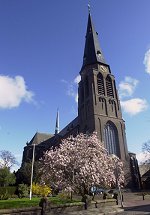
ALMELO - Saturday May 17, 2003 the Nederlandse Klokkenspel-Vereniging organised an International Carillon Competition, in cooperation with the Stichting Stadscarillon Almelo, on the carillon of the St.Georgius Tower. Earlier contests in Almelo took place in 1983 and 1990. Since 2001, the instrument has consisted of 48 bells in the range e-flat1 (c1) - f1 - chromatic - e-flat5. The garden of the presbytery was available as listening place.
In 1926 Gillett & Johnston cast 36 bells for the parish church of Almelo, a city with well over 70,000 inhabitants. With the addition of two Taylor-bells that were already present, an instrument of 38 bells was created. Unfortunately, 28 bells were removed from the tower in 1943. Petit & Fritsen added 29 new bells in 1951 and another 7 bells in 1963. When Nico Bruyn, the carillonneur at that time, left in 1971 at the age of 89, the condition of the carillon started to deteriorate. In 1982, the instrument of 47 bells was restored. During this process Eijsbouts replaced the 13 smallest bells.
COMPETITION
The competition started at 10.00 hours and ended at about 17.30 hours. Twelve carillonneurs competed in two categories: A - carillonneurs with a diploma, and B - carillonneurs without a diploma. The participants came from no less than five different countries: Malgosia Drzewiecka, Monika Kazmierczak (Poland); An Lommelen, Dina Verheyden (Belgium); Toru Takao (Japan); Ana Elias (Portugal); Hylke Banning, Roy Kroezen, Nan Los, Mathieu Polak, Esther Schopman, Jasper Stam (The Netherlands).
Candidates participating in category A were expected to perform the compulsory work Passacaglia, Koraal en Fuga composed by Beno´t J. Franssen (1893-1978). Participants in category B had to play two compulsory works: Intrada col Aria and Rondo Lidico, composed by John Courter (b. 1941) on the occasion of the addition in 2001 of the 48th bell, attached to the lowest e-flat pedal key. Each participant was granted a total of 20 minutes playing time.
JURY
The members of the jury were Sjoerd Tamminga (President), Luc Rombouts, Gideon Bodden, Freek Bakker and organist Gijs van Schoonhoven. The jury paid special attention to the technique of all candidates, the interpretation of the music, and the level of difficulty of the pieces played. The names of the participants were not made known to the jury before the contest. It was a bright and sunny day, though for ten minutes at the end the jury was unable to hear anything due to a very heavy downpour of rain.
PRIZE-WINNERS
Hylke Banning, City Carillonneur of Oldenzaal, was awarded the first prize in category A: EUR 500 and three recitals in 2004. In addition to the compulsory work, he also played the Rilke Fantasy by John Courter and Le Diable au Beffroi by Kors Monster. The second prize went to Roy Kroezen from Amersfoort: EUR 275 and one recital in 2004. His own choice compositions were Sonata A Cimbala Solo by Sybrand van Noordt and Suite III by Henk Badings.
In category B there were also two prizes to be presented. The first prize went to Monika Kazmierczak from Gdansk: EUR 375 and one rectial in 2004, while Jasper Stam from Kampen won the second prize: EUR 250. Monika played Passacaglia Antiqua per Campanae composed by Geert D'hollander. Jasper choose Klockedans by Wim Franken and Toccata, Lied en Fuga op 'Daar staat een klooster in Oostenrijk' composed by Staf Nees.
